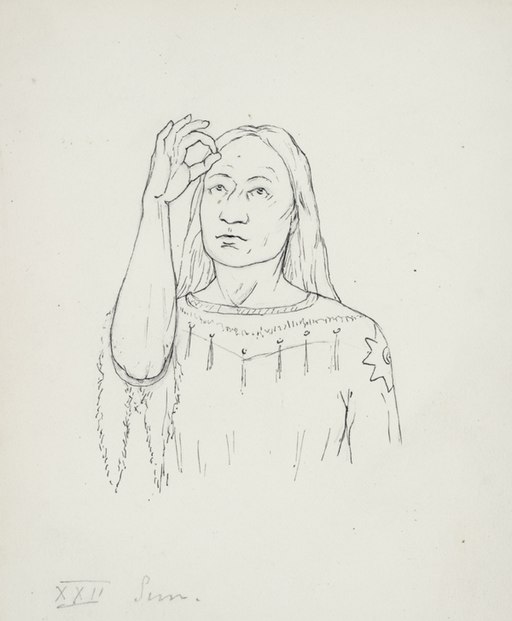
Learning About
ACCESSIBILITY
Communication
Sign Language
Indigenous Sign Languages
There are about 70 different Indigenous languages in Canada, with a variety of dialects grouped into 12 different language families based on shared vocabulary, sound correspondences, word structure, and other features of the languages (David Joseph Gallant, 2020).
In addition to spoken language, some Indigenous cultures have historically used sign language as a form of communication (Rice, K., 2020).
Language in every form is an important part of culture, and historically, the dismissal of Indigenous languages has been used as a tool of colonization. In a 2018 interview with the Tyee, researcher David Danos suggests “colonial governments tried to restrict the use of Indigenous Sign Language (ISL) because it was the main means for commerce and diplomacy among Indigenous nations” (The Tyee, 2018).
Indigenous Sign Language (ISL) has been recorded as being used since the early 16th century. Widely practiced across Canada and the US, communities developed complex ways of signing that were unique among “distinct genetic lineages” rather than universal. The development of American Sign Language (ASL) in the 1800’s can be largely attributed to ISL guides written by colonizers (The Tyee, 2018).
(Image Courtesy of Garrick Mallery, Introduction to the Study of Sign Language Among the North American Indians: As Illustrating the Gesture Speech of Mankind (1880).)
Plains Sign Language (PSL) is the most well-known ISL in Canada/the US – it has been used across the Prairies by the Cree, Dakota and Siksika, among others. It was also used by hearing individuals to visually narrate discussions (Rice, K., 2020).
Other Indigenous Sign Languages are Inuit Sign Language, used in the Canadian Arctic, and Plateau Sign Language, which is mostly a lost language now, but was historically used by the Salish, Ktunaxa and other Plateau peoples (Rice, K.,2020).
There have been recent efforts to revitalize these systems of communication, as the conversation around reconciliation and reparations have come to the forefront. In Canada in 2019, The Indigenous Language Act opens in new window recognized Indigenous Sign Language as one of the primary languages for communication by Deaf people (Indigenous Language Act, 2019).
The Accessible Canada Act opens in new window acknowledges that ASL, LSQ, and ISL are the primary languages of Deaf people in Canada (Accessible Canada Act, 2019).
Watch the 1930 Indian Sign Language Great Council’s meeting for examples of ISL and its importance:

Spotlight
Max and Marsha Ireland are working to revive and expand a traditional sign language for the Oneida Nation. They live near London, Ontario and are Haudenosaunee Shawnee of the Six Nations Iroquois, which include the Oneida Nation. Collaborating with Elder Olive Elm, the Irelands have come up with 250 signs, a 13-letter alphabet (which is just like spoken Oneida), and signs that count up to 100. They want to create an Oneida Sign Language based on Plains Indigenous Sign Language, which was once widely used by Indigenous people, rather than ASL (The Tyee, 2018).
Max is Marsha’s interpreter, and he gives a word to Elder Elm, who translates the word into Oneida and back into English. The Irelands then look at the Oneida language and Plains Sign Language and try to connect the two. The Irelands are also working on an Oneida Sign Language guideBook (CBC, 2018).
This video is an Oneida Thanksgiving Message in Oneida Sign Language
Black American Sign Language
Black American Sign Language (BASL) is another unsung sign language, developed and revitalized amidst oppression. The American School for the Deaf opened in 1817 and admitted its first Black student in 1825. After the Civil War, schools specifically for Black Deaf students became more common. Segregation affected the way that students were taught – Black Deaf students were more likely to learn signing and vocational training, whereas white Deaf students had a curriculum that focused almost exclusively on oralism – lip reading and speech. Much like with Indigenous Sign Language, Black American Sign Language was historically treated as an alternate or “lesser” form of ASL, rather than its own equally important and influential dialect (New York Times, 2021).
Black American Sign Language has noticeable differences to ASL – BASL uses two-handed signs rather than one, and BASL users place their signs closer to their faces rather than their torsos (The New York Times, 2021).
The popularity of African American Vernacular English opens in new window in spoken language is reflected in BASL, too, as witnessed in TikToker Nakia Smith’s popular videos. Smith is committed to uplifting other Black Deaf creator’s stories and carrying on the proud tradition of BASL.
Watch an intro to BASL by Nakia Smith below:
Watch the 2020 documentary Signing Black in America below:




